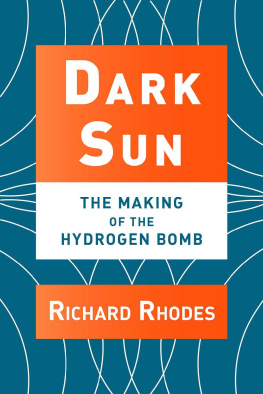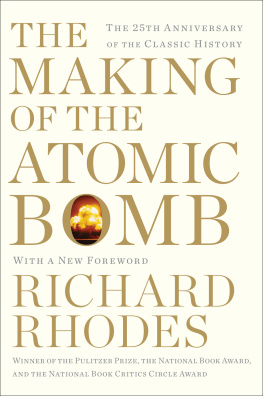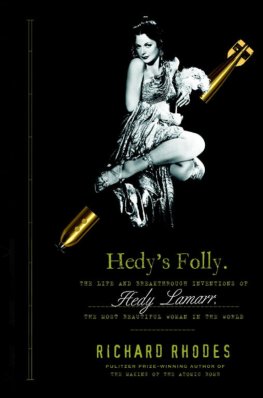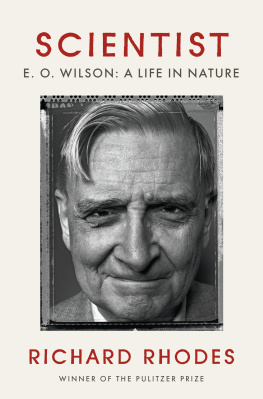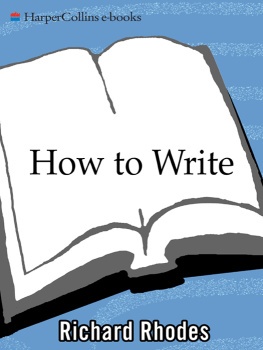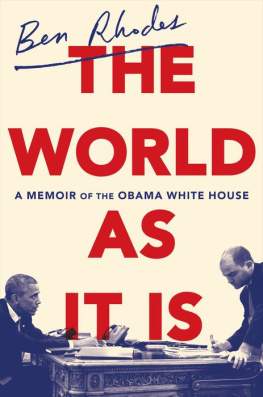Richard Rhodes - Arsenals of Folly
Here you can read online Richard Rhodes - Arsenals of Folly full text of the book (entire story) in english for free. Download pdf and epub, get meaning, cover and reviews about this ebook. year: 2007, publisher: Knopf Doubleday Publishing Group, genre: Non-fiction. Description of the work, (preface) as well as reviews are available. Best literature library LitArk.com created for fans of good reading and offers a wide selection of genres:
Romance novel
Science fiction
Adventure
Detective
Science
History
Home and family
Prose
Art
Politics
Computer
Non-fiction
Religion
Business
Children
Humor
Choose a favorite category and find really read worthwhile books. Enjoy immersion in the world of imagination, feel the emotions of the characters or learn something new for yourself, make an fascinating discovery.

- Book:Arsenals of Folly
- Author:
- Publisher:Knopf Doubleday Publishing Group
- Genre:
- Year:2007
- Rating:5 / 5
- Favourites:Add to favourites
- Your mark:
- 100
- 1
- 2
- 3
- 4
- 5
Arsenals of Folly: summary, description and annotation
We offer to read an annotation, description, summary or preface (depends on what the author of the book "Arsenals of Folly" wrote himself). If you haven't found the necessary information about the book — write in the comments, we will try to find it.
Arsenals of Folly — read online for free the complete book (whole text) full work
Below is the text of the book, divided by pages. System saving the place of the last page read, allows you to conveniently read the book "Arsenals of Folly" online for free, without having to search again every time where you left off. Put a bookmark, and you can go to the page where you finished reading at any time.
Font size:
Interval:
Bookmark:
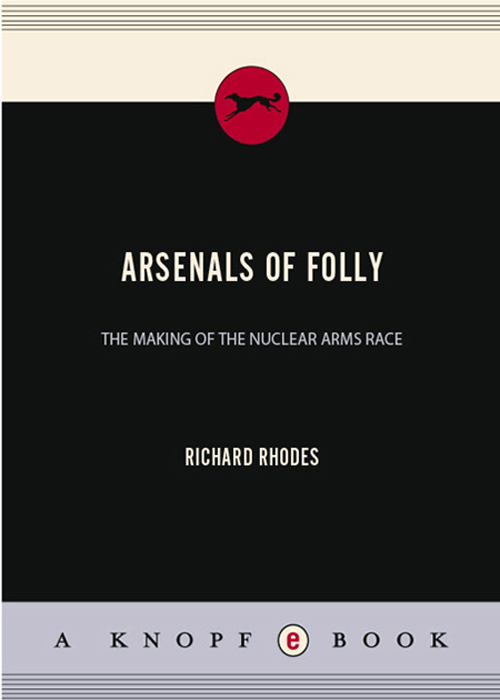

Contents
For Chuck Hansen, 19472003
A grant from the Alfred P. Sloan Foundation supported the research and writing of this book.
Reality is that which, when you dont believe in it, doesnt go away.
PETER VIERECK

What happened in this country was that a rigid system was created, and then life was herded into it.
MIKHAIL GORBACHEV
ONE TO THE CHERNOBYL SARCOPHAGUS
ON THE SATURDAY MORNING IN APRIL 1986 when the alarms went off at the Institute for Nuclear Power Engineering of the Byelorussian Academy of Sciences, in a forest outside Minsk, the nuclear physicist Stanislav Shushkevich thought the institutes reactor was bleeding radiation. Its fuel assemblies, sealed inside aluminum cassettes at the bottom of a deep, stainless-steel tank full of distilled water, might have sprung a leak. Or something might have spilled in the institutes radiochemistry lab. Dosimeter operators began working their way methodically through the labs and offices and found radiation everywhere. It was in peoples hair and clinging to their clothes. It registered two hundred times normal on the air filters. It was near danger levels at the front door.
The dosimetrists moved outside and discovered it there as well: on the sidewalk, on the grass, on the periwinkle crocuses pushing up through the dark litter of the forest floor. So the institute wasnt the source. An order over the public-address system warned everyone to stay indoors. Someone called the Lithuanian nuclear-power complex at Ignalina, one hundred miles northwest, and radiation was everywhere there too. Chernobyl, in the Ukraine, was farther away, two hundred miles southeast, where four big RBMK thousand-megawatt reactors were lined up end to end in a building almost a mile long. Hundreds of people worked there, but the phones rang unanswered. Something was wrong at Chernobyl.
By afternoon, institute chemists had found radioactive iodine in the fallout, which confirmed that a reactor had exploded. For radioactive gas and smoke from Chernobyl to have reached Minsk, the explosion must have occurred sometime during the night. How much radioactivity had been released? How much more would follow? Why had no one warned them?
Shushkevich, fifty-two, a solid, ample man with a ruddy face and a high, domed forehead fringed with graying brown hair, was friendly and avuncular but shrewdly intelligent. He was vice-provost of the Byelorussian University in Minsk, a liberal humanist in the tradition of Andrei Sakharov. The Soviet Unions change of direction since the death of Konstantin Chernenko in March 1985, just thirteen months before, had filled him with hope. Chernenko, an emphysemic general secretary with the soul of a retired file clerk, had served as a placeholder between the reform-minded but ailing former KGB chief Yuri Andropov and his vigorous young heir apparent, Mikhail Gorbachev. At Chernenkos death his private safe had turned up no personal diary or other intimate record, only a large cache of money no one could account for. Good riddance, Shushkevich had thought: I was the first at the university to put a portrait of Gorbachev on the wall.
The night of Chernenkos death, Raisa Maksimovna, Mikhail Gorbachevs wife and partner, pacing beside him in the garden of their country house near Moscow, heard him say resolutely, We just cant go on like this. The next day, 11 March 1985, Gorbachev had been elected general secretary at a meeting of the Communist Party Central Committee. In his acceptance speech immediately after his election he had called for open government and accountability: I emphasized the need for transparency (glasnost) in the work of Party, Soviet, state and public organizations, he wrote later. He had laid out in detail his other fundamental goal, perestroikaeconomic restructuring, salvaging the nearly moribund Soviet economyat a Central Committee plenum the following month, stressing the elimination of everything that interferes with development.
The huge Soviet military-industrial complex, which insinuated itself into every corner of the Soviet economy and consumed at least 40 percent of the state budget, headed his list for cutbacks, and in a letter delivered to President Ronald Reagan on 15 January 1986 he had broached a proposal without precedent across the four dangerous decades of the U.S.-Soviet nuclear-arms race: A concrete program, as he described it during a press conference in Moscow later that day, for the complete liquidation of nuclear weapons throughout the worldbefore the end of the present century. Opening to such unprecedented initiative, 1986 had seemed a year of immense possibility. Now a disaster loomed, of consequences yet unknown, and radiation blew north from Chernobyl.
At 2:30 on Saturday afternoon someone finally called the institute to report an accident at Chernobyl. In the early hours after midnight, Chernobyl Reactor Number Four had run away in four seconds from 7 percent of maximum rated power to about one hundred times maximum rated power, an event called a prompt critical excursion that had flashed the reactors thousands of gallons of circulating water to high-pressure steam. The graphite core of the massive, concrete-encased reactor was an enclosed cylinder forty feet in diameter and twenty-three feet tall, set on end, with blocks of concrete and a water pool beneath it to absorb the fierce radiation its zirconium-clad uranium fuel elements produced, and a two-million-pound, disk-shaped upper biological shield of concrete blocks set over it like a lid to protect workers from radiation exposure. In the same spirit of bravado that had prompted the scientists at Los Alamos during the Second World War to nickname the atomic bomb they were building the gadget, the men who operated the RBMKs called the upper biological shield the pyatachok, Russian for one of the smallest Soviet coins, the five-kopek piece. When the water flashed to superheated steam and the reactors steam pipes started exploding, an eyewitness reported later, the pyatachok began to bubble and dance.
Then two explosions in the space of less than four seconds tore open the reactor and blew out the building. The reactor core was sealed within a metal tank filled with a mixture of helium and nitrogen to prevent the graphite moderatorfour million pounds of pure carbonfrom burning. The prompt critical excursion had heated the graphite red hot. The first steam explosion lifted the two-million-pound pyatachok. At the same time the steam burst down through the metal tank and penetrated the red-hot graphite. Steam combines ferociously with hot carbon to make carbon monoxide, liberating hydrogen; the second and more powerful explosion combined steam and exploding hydrogen gas, tilted up the pyatachok nearly vertical, shattered the upper half of the reactor core, and blew tons of its red-hot radioactive debrisa rubble of highly irradiated uranium-oxide fuel as well as radioactive graphite and zirconiumpast the pyatachok, through the roof, and half a mile into the air.
It fell out by size. Big blocks of hot graphite landed on the roofs of Number Fours turbine hall and Reactor Number Three. To lower construction costs, the roofs had been covered with flammable asphalt; the hot graphite set them on fire. Blocks and smaller pieces of graphite landed on the grounds around the building and splashed hissing into the four-mile-long cooling pond that lay between the plant and the Pripyat River. The cooling pond was fed by and drained into the river, which drained in turn into the big reservoir downstream that stored the water supply of the city of Kiev, the Soviet Unions third-largest city, with a population of some 2.5 million people.
Next pageFont size:
Interval:
Bookmark:
Similar books «Arsenals of Folly»
Look at similar books to Arsenals of Folly. We have selected literature similar in name and meaning in the hope of providing readers with more options to find new, interesting, not yet read works.
Discussion, reviews of the book Arsenals of Folly and just readers' own opinions. Leave your comments, write what you think about the work, its meaning or the main characters. Specify what exactly you liked and what you didn't like, and why you think so.

